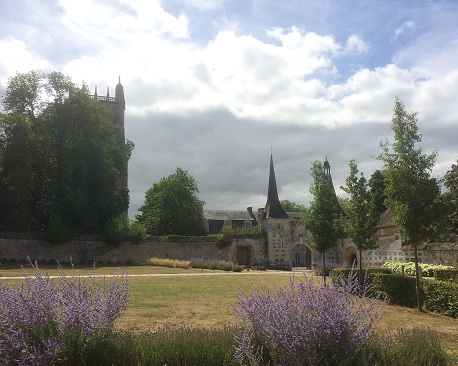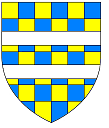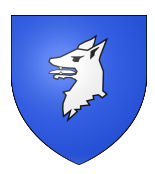Baldwin FitzGilbert
de Meules et du Sap


Gilbert de Brionne, seigneur du Sap
Le Sap was part of the territory of Gilbert fitz Geoffrey, Count of Eu and Count of Brionne, an influential noble also known by the name Gilbert Crispin because of the style of his hair. His curly hair stood up like the branches of a pine tree. The territory of Le Sap was given to him by Duke Robert I of Normandy in 1030. The territory was originally composed of three ‘châtelenies’: 1) the one of Le Sap, with many communities of Ouche and the old country of Exmois; 2) the one of Bienfaite; and 3) the one of Orbec, with the ‘seigneurie’ of Meules.

During his life Gilbert lost the County of Eu but he kept the County of Brionne and Brionne Castle. Gilbert de Brionne was a benefactor of the abbey of Le Bec founded by his former knight Herluin in 1031. Since 1035 Gilbert also was one of the guardians of Duke William II in his younger years. Gilbert was murdered in 1040 while he was riding peacefully in the morning.
His sons Richard and Baldwin were taken to Count Baldwin V of Flanders for refuge. They had their education at the court in Lille. At the request of the Count of Flanders, Duke William II, when he married Matilda of Flanders in c. 1051, gave Richard the lordships of Bienfaite and Orbec and Baldwin the lordships of Meules and Sap. It could be seen as an act of restoration. Baldwin was also given the forest of Avranches. Duke William considered their father Gilbert as one of the pillars of the Norman society in difficult times. In the entourage of Matilda of Flanders the sons of Count Gilbert returned to Normandy and became members of the Court of Duke William in Rouen. They strenghtened their relationship with the abbey of Le Bec, a centre for religious, philosophical, legal and administrative excellence.



of Le Bec
Battle of Hastings
Richard and Baldwin were consulted by Duke William of Normandy before the attack and accompanied him in the battle of Hastings (14 October 1066) and in the Norman conquest of England. Both are mentioned by Robert Wace: E. dam Richard ki tient Orbec, E ki sire de Bonnebos, E cil du Sap et cil de Glos, E cil ki duné tenant Tregoz.

On the fall of Exeter in 1068 King William left Baldwin to keep the city and to complete the building of Rougemont Castle (a royal castle). After the conquest the brothers Richard fitz Gilbert and Baldwin fitz Gilbert were greatly enriched. Richard was the founder of the illustrious Clare family. In reward for his eminent services during the Battle of Hastings, Baldwin became castellan of Rougemont Castle in Exeter, Sheriff of Devon and the first baron of Okehampton. Baldwin and Richard are named in a 1081 charter of King William I to St. Peter’s, Ghent, Flanders.



S. Hooper (1784)


Tree of Sap and Okehampton
Richard I
Duke of Normandy
† 996
Geoffrey (or Godfrey)

Count of Eu and Count of Brionne
† 1015

Gilbert
Count of Eu, Count of Brionne and Count of Hiesmes, seigneur du Sap
† 1040

He probably married Adelise of Flanders. Gilbert de Brionne had the following children:
- Richard fitz Gilbert, seigneur de Bienfaite et Orbec, Lord of Clare and Tonbridge. His descendants carried the name ‘de Clare’.
- William fitz Gilbert † 1060
- Baldwin fitz Gilbert, seigneur de Meules et du Sap
- Adela fitz Gilbert, married Neel II de Saint-Saveur, Vicomte du Cotentin
Baldwin fitz Gilbert
Baldwin was probably born in Eu or Brionne in 1030 and was seigneur de Meules et du Sap since c. 1050. After 1066 King William appointed him governor of Rougemont Castle in Exeter, hereditary Sheriff of Devon and the first baron of Okehampton. Baldwin the Sheriff was also called Baldwin the Viscount, Baldwin of Exeter, ‘de Moles’, ‘de Sap’, or ‘de Brionne’. Besides supervising the building of the royal castle at Exeter, he built Okehampton Castle between 1068 and 1086 and encouraged the growth of a borough. He had almost 200 manors in Devon, Dorset and Somerset and property in Exeter and Barnstaple.
† 1090

Attributed arms of Baldwin fitz Gilbert, first baron of Okehampton (by Sir William Pole)
Baldwin married Emma (Albreda) d’Avranches (1032-1088), daughter of Richard le Goz, vicomte d’Avranches and Emma de Conteville, daughter of the mother of King William I. Their children were:
- Robert fitz Baldwin, seigneur de Meules et du Sap, governor of Brionne † 1101
- William fitz Baldwin, baron of Okehampton, Sheriff of Devon, founder of Cowick Priory (dependant upon the abbey of Le Bec), builder of the royal castle of Rhydygors near Camarthen, Wales † 1096
- Richard fitz Baldwin, de Brionne, baron of Okehampton, Sheriff of Devon, re-establisher of Rhydygors Castle in 1106, founder of Brightley Abbey † 1137
- Adelise fitz Baldwin, de Brionne, Lady of the Manor of Thorncombe, Lady of Okehampton, Lady Sheriff of Devon, founder of a chapel in Exeter Castle, founder of Forde Abbey (Dorset) † 1142
- Emma fitz Baldwin, Lady of the Manor of Dolton (Dueltone) † 1118
- Guiger, a natural son, who became a monk of the abbey of Le Bec † 1133



Emma fitz Baldwin married 1 William Avenel † 1074. The name of their son was Ranulf Avenel. ‘Upcott was given to William Avenel by William the Conqueror, through the interest of Baldwin de Sap, or DeBrioniis, whose youngest daughter, Emma, he had married’ (Sir Bernard Burke). William Avenel, seigneur des Biards, was present at the battle of Hastings.
Emma fitz Baldwin married 2 William fitz Wimund d’Avranches, seigneur de la Haie Paynel (1037-1087). Coming from Avranches William was a knight who had also fought under the command of William the Conqueror at Hastings. William fitz Wimund was named in Domesday and was a benefactor of Mont-Saint-Michel. He settled and died in Okehampton.

In 1058 William fitz Wimund d’Avranches had first married Lesceline de Normandy, daughter of William of Eu and Lesceline, daughter of Turquetil de Harcourt. The second marriage of William d’Avranches was in 1070 with Matilda (Maud) d’Arques, daughter of William d’Arques of Folkestone, Kent, and Beatrice Malet. The third marriage of William d’Avranches was in 1074 with Emma fitz Baldwin de Brionne, the widow of William Avenel.
The children of William fitz Wimund d’Avranches and Emma fitz Baldwin, Lady of Dolton, were: 1) Robert, 2) Emma (she married William Paynel, baron of Hooton Pagnell, Lord of Les Moutiers-Hubert and Hambye), 3) Gilbert, 4) Turgis (bishop of Avranches) and 5) Rualon (Sheriff of Kent, later Lord of Folkestone, father of Robert d’Avranches de Hougham). The eldest son of Emma fitz Baldwin and William fitz Wimund d’Avranches was:
Robert fitz William d’Avranches (1075-1137)

Robert d’Avranches was favoured by his uncle Richard fitz Baldwin, Lord of Okehampton, who made the tenants of Okehampton swear fealty to Robert, son of Emma fitz Baldwin of Dolton, as his heir (to become Lord of Meules and Sap, baron of Okehampton, heriditary Sheriff of Devon and Castellan of Exeter in the future). Robert in 1104 first married Matilda, daughter of Randolph Avenel (brother of William Avenel) and Adeliza de Redvers. His second marriage in 1129, arranged by King Henry I, was with Hawise de Dol, daughter of Godwin, seigneur de Dol (Bretagne), and Noga Tinteniac. Robert and Hawise had a daughter named Maud (Matilda).

But Robert died in 1137. So heiress Adelise fitz Baldwin (aunt) appointed as her heir her nephew Ranulf Avenel. Ranulf Avenel exercised some of the rights of the barony of Okehampton for a while. Between 1135 and 1154 there was a lot of confusion in England during the civil war. Empress Matilda made Baldwin de Redvers, who had rebelled against King Stephen, Earl of Devon in 1141. Because Ranulf was in conflict with Reginald de Dustanville, Earl of Cornwall, son of King Henry I, Ranulf was deprived of the honour of Okehampton by King Henry II. It was, with no objection, decided that Maud (Matilda), daughter of Robert fitz William d’Avranches (a half-brother of Ranulf Avenel) and Hawise de Dol, was the sole heir. So it became possible to assure the estates for the interests of the Angevin or Plantagenet empire.
Maud (Matilda) d’Avranches
Dame du Sap, Lady of Okehampton
In 1137 Maud (Matilda) d’Avranches married 1 William de Courcy.
In 1162 Maud (Matilda) married 2 Robert fitz Roy (1093-1172), a natural son of King Henry I and Edith.
The daughter of Maud (Matilda) d’Avranches and William de Courcy was
Hawise de Courcy d’Aincourt, Lady of Okehampton † 1219
The daughter of Maud d’Avranches and Robert fitz Roy was
Maud (Matilda) fitz Robert fitz Roy, Dame du Sap † 1224
Maud du Sap married Renaud I de Courtenay † 1190. Renaud (Reginald) I de Courtenay was a former crusader who came to England from France in 1152. He was a friend of King Henry II of England and the king made him Lord of Sutton, Berkshire. This had belonged to William the Conqueror. The marriage of Renaud (Reginald) I de Courtenay with Maud du Sap – one of the heirs of the legacy of Baldwin FitzGilbert de Meules et du Sap, Sheriff of Devon and baron of Okehampton – was arranged by King Henry II. Renaud (Reginald) I de Courtenay was appointed governor of Exeter Castle.

Hawise de Courcy married Renaud (Reginald) II de Courtenay † 1194
Hawise and Renaud (Reginald) II had a son
Robert de Courtenay
baron of Okehampton † 1242
Robert married Mary de Vernon, daughter of the (de Redvers) Earl of Devon.


Le Sap is an old town in Normandy, under Lisieux and on the road from Caen to Paris, close to the Castle of Falaise. The original name of the place was ‘Sappo’ or ‘Sappus’ (1030-1040) and ‘Sappum’ according to Orderic Vital around 1100, a monk of the abbey of Saint-Evroult and the first historian of Normandy. The word is related to the French word ‘sapin’ (fir tree). Le Sap was a fortified place and had a castle, later named ‘Fort Montpellier’. Le Sap has been besieged many times, but it is still possible to see elements of the ancient fort. Nowadays Le Sap is famous for apple cider and Calvados (Apple Brandy).





Roger du Sap
It was Roger du Sap, originally from Le Sap, who has made the name ‘du Sap’ more well-known. Roger du Sap was the Abbot of the benedictine abbey of Saint-Evroult from 1091 till 1123, a famous place of worship and learning in the middle ages in Europe. The abbey of Saint-Evroult was founded in 1050 and Roger had entered into monastical life around 1070. He was a friend of Lanfranc (1005-1089), a famous teacher of the Bec Abbey, born in Pavia, who was made archbishop of Canterbury in 1070 by King William I. Roger du Sap travelled to England regularly. His brother Odon du Sap was the Prior of the abbey of Saint-Evroult.




The Family
Noteworthy is that the movie ‘The Family’ (2013), also released under the name ‘Malavita’, was filmed in Le Sap. It was directed by Luc Besson and includes famous actors as Robert De Niro, Michele Pfeiffer and Tommy Lee Jones.





Painting by W. Johnson (1990)







All Saints’ Church, Sutton Courtenay

Norman Hall, Sutton Courtenay
Literature
M. Couriol, Le Sap. Historie de la commune du Sap ou description topographique, statistique, chronologique et historique de ce lieu en de son territoire actuel. Le Sap, Le Grand-Sap, Saint-Pierre-du-Sap. Sapum, Castrum Sapinorum, Sapinus major, Sanctus Petrus Sapinorum. Paris, Le Livre d’histoire, 1860, 2008.
F. Desbuards, Brionne à vol d’oiseau (1887). Paris, Res Universis, 1993.
A. Endecott, Tales of Old Ockington, Chudleigh, Orchard Publications, 2002.
V. Gazeau, Normannia monastica. Princes normands et abbés bénédictins (Xe-XIIe siècle). Caen, Publications du CRAHM, 2007.
R.A. Higham, Okehampton Castle. London, English Heritage, 1984.
P. Planel, Okehampton Castle. A Handbook for Teachers. English Heritage, 1992.
J. Pougheol, Le Sap. Art de Basse-Normandie, No. 75, Automne 1978.
Powderham Castle. Historic Family Home of the Earls of Devon. Derby, Heritage House, 2006.
P. Rex, William the Conqueror. The Bastard of Normandy. Gloucestershire, Amberley Publishing, 2012.
C. Tyler, Forde Abbey. The Story Behind the Stones. Stanbridge, Wimborne Minster, Dorset, The Dovecot Press, 2017.



